
My Sky Blog – Page 2
________________________________________________________________________________________
 Starling
Starling
February 3 Outreach Program at a Nashville Area Elementary School
 On February 3rd, I had the great pleasure of presenting to an outstanding group of fourth graders at a local elementary school. The 28 inquisitive students were very attentive and asked excellent questions. One little girl had lived in Argentina and had also visited Chile’s Atacama desert, and she agreed the skies in Chile are magnificent. During my presentation, I mentioned the solar eclipse of August 21, 2017, which is a major astronomical event for these kids to follow. Parts of their local community will provide high percentage totality experiences during the eclipse. It’s sure to be an experience they will all remember. I also showed the kids pictures that I have taken from my home observatory. Based on their feedback, I think there could be some future scientists among them!
On February 3rd, I had the great pleasure of presenting to an outstanding group of fourth graders at a local elementary school. The 28 inquisitive students were very attentive and asked excellent questions. One little girl had lived in Argentina and had also visited Chile’s Atacama desert, and she agreed the skies in Chile are magnificent. During my presentation, I mentioned the solar eclipse of August 21, 2017, which is a major astronomical event for these kids to follow. Parts of their local community will provide high percentage totality experiences during the eclipse. It’s sure to be an experience they will all remember. I also showed the kids pictures that I have taken from my home observatory. Based on their feedback, I think there could be some future scientists among them!
_______________________________________________________________________________________
 Starling
Starling
1/30/16 – High School Robotics Competition

On January 30, 2016, my school’s robotics team competed in its first ever competition. I co-founded the team this year, and I served as the Programming Captain. Throughout my team’s preparation for the competition, I taught some of the younger members of the team how to code so they could take my place once I’ve graduated. My team’s job was to program the robot to complete a series of tasks, both in a 30 second autonomous mode, in which we could not manually operate the robot, and a manual mode. Robots can score points by pressing specific beacons, parking in certain locations, activating triggers on ramps, placing debris in buckets, climbing up certain levels of the ramp, and hanging from a pull-up bar. Our robot managed to complete a number of these tasks during competition, which was very exciting.
The FIRST Tech Challenge (FTC) competition allows teams to use either an MIT App Inventor or Java through Android Studio. My team chose to work with Java, because it gave us more flexibility in the autonomous mode. My teammates had little to no programming experience prior to the formation of our team. Luckily, I was knowledgeable in the languages Python, Fortran, and MATLAB, and several of us worked together to learn Java. Although it was our first time at a competition, our team won the Judges Award and reached the finals for the Think Award (engineering notebook), Control Award (coding), and Community Award. It was gratifying when many hours of programming effort paid off. We were finalists for the Control Award, which is given to the team that demonstrates innovative thinking in developing the control system that allows the robot to complete tasks and maneuver through the course. It was such a fun and rewarding experience to be part of my school’s newly formed robotics team and contribute to a great team effort. I’m excited to see what the team will accomplish in the coming years. It would be fascinating to work on a team that designed robotic landers and rovers for NASA!
________________________________________________________________________________________
 Starling
Starling
1/13/2015 – Lots of Upcoming Outreach Programs!
I’m really excited about the outreach programs I have scheduled over the next few weeks. By the end of February, I’ll have presented to more than 200 students across Middle Tennessee. New opportunities keep presenting themselves, including programs for elementary school students that I’ve been invited to do, and this has led me to expand my outreach efforts to include younger students. I love sharing the wonders of astronomy with young students! Look for updates and photos soon, both here and on my outreach page.
________________________________________________________________________________________
 Starling
Starling
Presentation by the Director of the Vatican Observatory
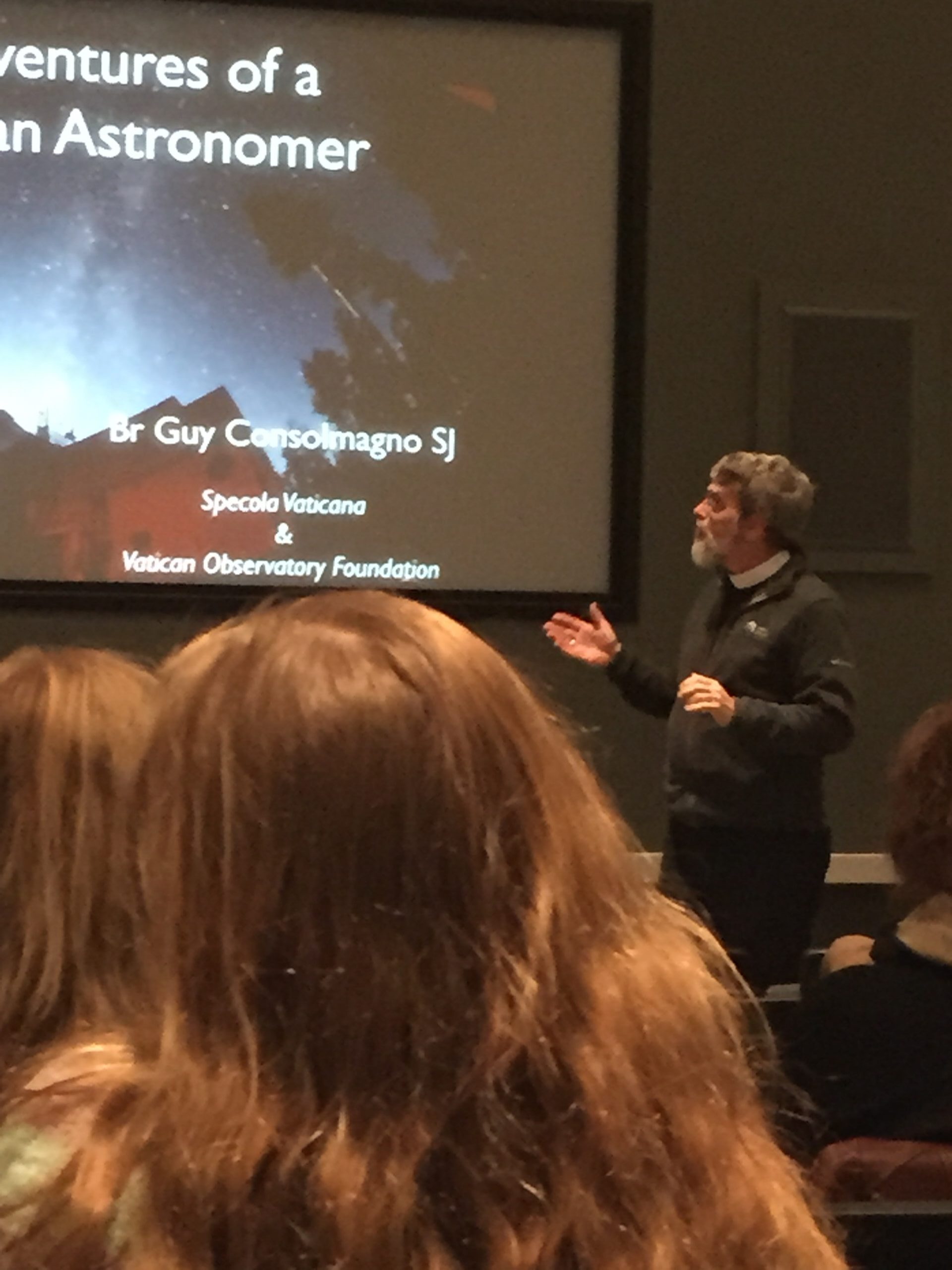
On December 7, I attended a talk by Brother Guy Consolmagno, the Director of the Vatican Observatory. Consolmagno, an MIT and University of Arizona graduate, discussed the Catholic Church’s involvement in astronomy, anecdotes on his life and career as a researcher, and his experiences working for the Vatican and overseeing its extensive collection of meteorites. It was a fascinating presentation in all respects, and I particularly appreciated his reflections on the interplay between faith and science.
________________________________________________________________________________________
 Starling
Starling
New Astrophotos of DSOs Taken 12/4/2015
Last Friday night, skies were clear, and I took some wide angle photos of several iconic deep-sky objects that are prominent this time of year. I used our Canon 6D DSLR camera mounted at the prime focus of our 5-inch Borg refractor operating at f/3.9. This gave nice, wide field views of the Pleiades (pronounced “ˈplē-ə-ˌdēz”), the Rosette Nebula, the Double Cluster in Perseus, the Andromeda Galaxy, the Triangulum Galaxy, and Orion’s belt. Image processing is time-consuming, but the full-sized versions of the first five photos from this session can be seen on my website here. The two thumbnail photos below offer a preview:
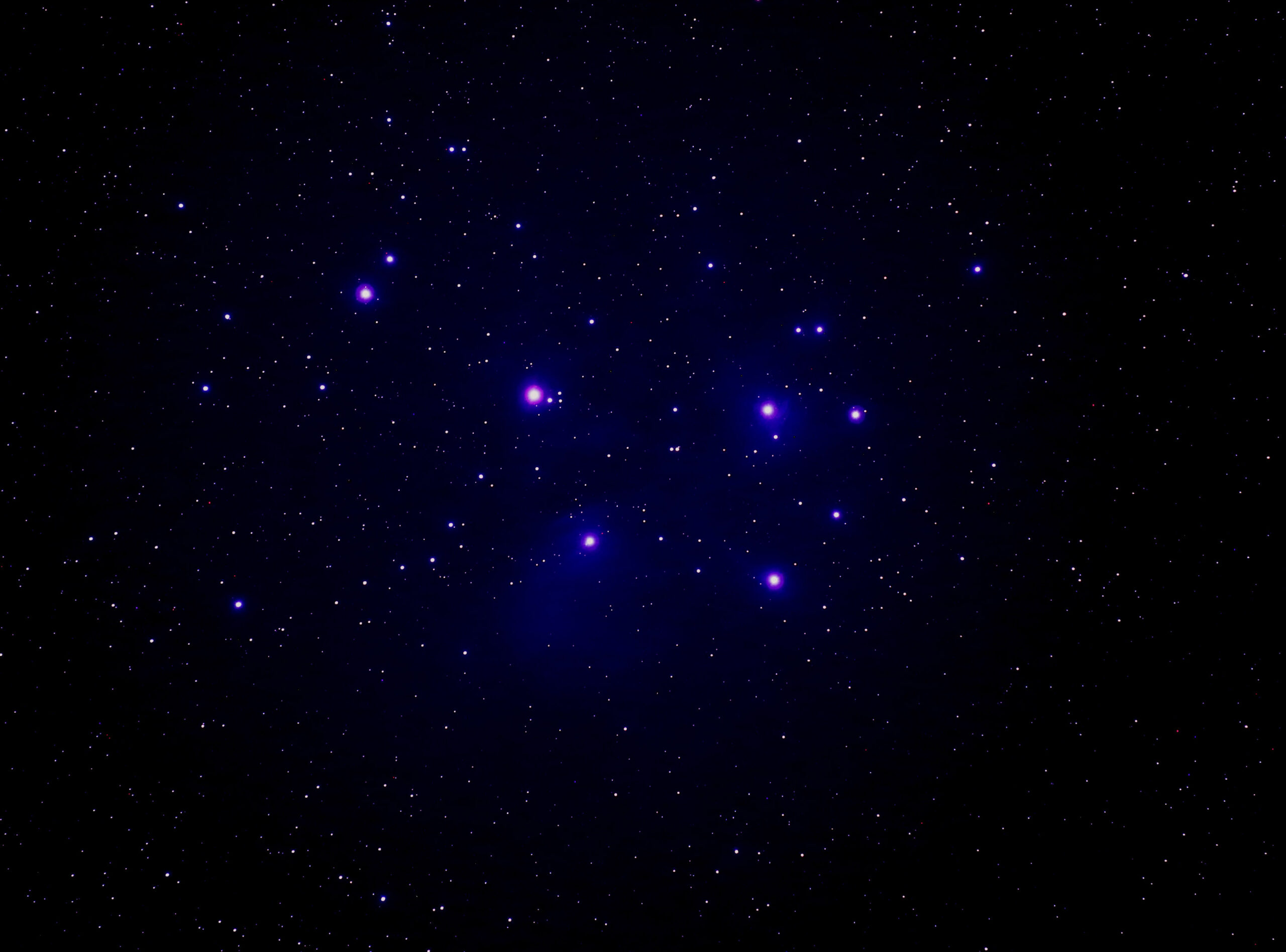

________________________________________________________________________________________
 Starling
Starling
Community Outreach Event – 11/22/2015
On November 22, I hosted an observing session for members of a church in our community. Fortunately, the skies were clear, allowing us some great views of the Moon, the Ring Nebula in Lyra, the Dumbbell Nebula in Vulpecula, M15 in Pegasus, the Andromeda Galaxy, and the Double Cluster in Perseus. More information about this event appears on my “Outreach” page here.

________________________________________________________________________________________
 Starling
Starling
Astronomers Use Spectroscopic Analysis to Postulate a Neptune-Sized Exoplanet 100 Million Light Years Away
Has Blue Skies
Astronomers announced on November 20 that they had used relatively modest-sized telescopes ranging from 1 to 2 meters at various sites around the world that are part of the Las Cumbres Observatory Global Telescope Network to obtain spectroscopic data from the upper atmosphere of GJ 3470b, an exoplanet roughly four times the size of Earth. GJ 3470b orbits a red dwarf star located approximately 100 million light years away. Specifically, they detected “Rayleigh scattering,” which is a term for light that has been scattered by tiny particles in GJ 3470b’s upper atmosphere, as the planet passed in front of the star it orbits as viewed from Earth. GJ 3470b is the smallest exoplanet where Rayleigh scattering has been detected to date. Interestingly, the spectroscopic readings for GJ 3470b suggest that the skies in its hazy upper atmosphere would appear blue, similar to skies on Earth. Unlike Earth, however, GJ 3470b appears to have a thick, hydrogen/helium dominated lower atmosphere. These findings were reported in the November 20 issue of the online Astrophysical Journal, which can be found here. One line from the article that particularly caught my eye is the following: “Our results demonstrate the feasibility of exoplanet atmospheric characterization from the ground, even with meter-class telescopes.”
________________________________________________________________________________________
 Starling
Starling
Highly Anticipated Near Earth Asteroid Turns Out to Be a Dead Comet
As Halloween approached this year, instead of picking out a costume or looking forward to greeting trick-or-treaters, I was eagerly awaiting the arrival of “Asteroid 2015 TB145,” which was expected to make the closest approach to Earth of any similarly-sized asteroid in nearly a decade. Scientists at the University of Hawaii discovered the object on October 10, 2015, using the Panoramic Survey Telescope and Rapid Response System (a/k/a Pan-STARRS-1). It was calculated the object would pass just 1.3 lunar distances from Earth. I began preparing a checklist of what I’d need to have ready to image 2015 TB145 with CCD cameras and my LISA spectrograph so I could add the data to my Near Earth Asteroid (NEA) research project that’s discussed on my website here. As Halloween approached, it became apparent that I’d be clouded out. My disappointment was tempered a bit when NASA announced that 2015 TB145 wasn’t an asteroid at all, but a dead comet. Members of the news media seemed intrigued by the odd, skull-like appearance of the object in radar images like the one below taken by the National Science Foundation’s 305-meter (1,000-foot) Arecibo Observatory in Puerto Rico.

Image credit: NAIC-Arecibo/NSF.
________________________________________________________________________________________
 Starling
Starling
My Lead-Off Middle School Outreach Event – 10/24/2015
On October 24, I kicked off my middle school outreach program by hosting a group of middle school girls for a tour of our observatory and a planetarium show. It was great fun! See my “Outreach” page here for more information about this event.

________________________________________________________________________________________
 Starling
Starling
NASA Announces Liquid Water Still Flows on Mars – 9/28/2015
NASA announced today the discovery of strong evidence that liquid water currently flows in certain places on Mars! This is a monumental discovery, because it increases the possibility that the Martian surface could harbor life. It also is further evidence of how abundant H2O is on the red planet, which could have important implications for the sustainability of any human bases that may someday be established there.
________________________________________________________________________________________
 Starling
Starling
“Supermoon” Total Lunar Eclipse – 9/27/2015
Tonight’s full moon occurred while the moon was at perigee — its closest point to the Earth in its elliptical orbit. As a result, the moon appeared around 14% larger than it does when it’s at apogee, which is its farthest point from the Earth in its orbit. When this occurs, the phenomenon is often referred to as a “supermoon.” Tonight’s “supermoon” was even more special, because for the first time in over 30 years, the supermoon coincided with a total lunar eclipse, where the entire lunar disk passed within the shadow of the Earth. When this occurs, the normally bright full moon dims considerably and turns a deep hue of red when viewed from Earth.
Unfortunately, the skies where I live were almost entirely overcast tonight. But during the period of just over an hour when the moon was fully eclipsed, I was able to view it for brief moments with the naked eye and through binoculars through intermittent holes in the clouds.
NASA has produced a short, animated movie explaining this “supermoon” eclipse:
[Link to NASA animated supermoon eclipse movie]
________________________________________________________________________________________
 Starling
Starling
First Lunar Photos – 9/21/2015
I made my first attempt at imaging the moon on September 21. Here’s a shot of the waxing crescent moon I took with our 8 inch refractor and ZWO120MM camera.
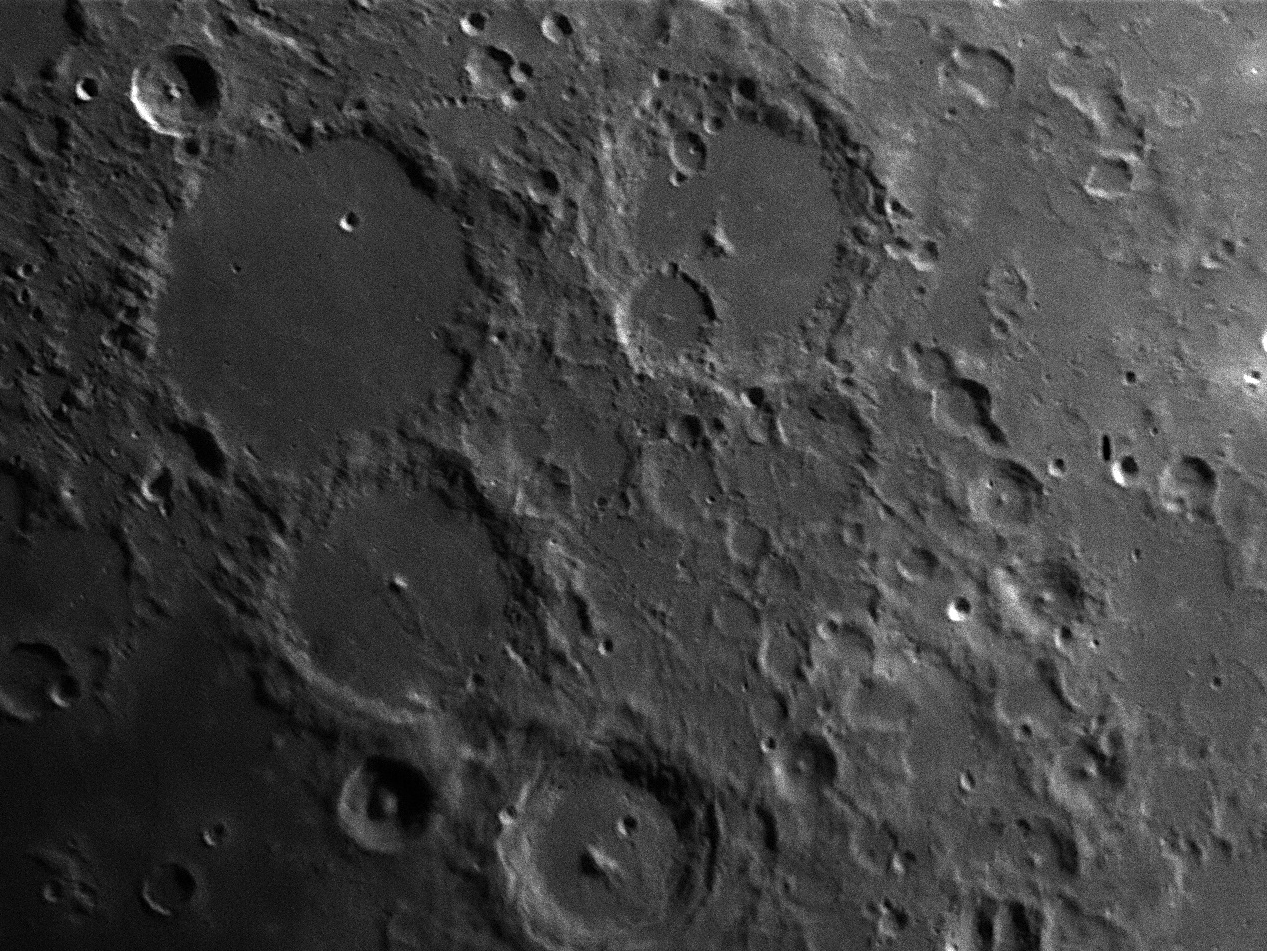
This is the same setup I used for the planetary images on my “Planet Photos” page. I haven’t had the chance to use Photoshop to try to bring out additional details yet, other than a quick use of the “Sharpen” filer tool. Seeing was not all that great during this imaging session, which made it tough to tell if the image was as sharply focused as it could have been. Pretty cool for a first try, though!
The largest crater in my photo is Ptolemaeus, which appears in the upper left-hand corner of the picture. For reference, here’s a NASA photo of Ptolemaeus that Apollo 16 took from lunar orbit:

________________________________________________________________________________________
 Starling
Starling
A Look Back at NASA’s New Horizons July Pluto Flyby
After decades of speculation about what the surface of distant Pluto looks like, we finally know! Here are some of my favorite photos from this summer’s New Horizons NASA mission:
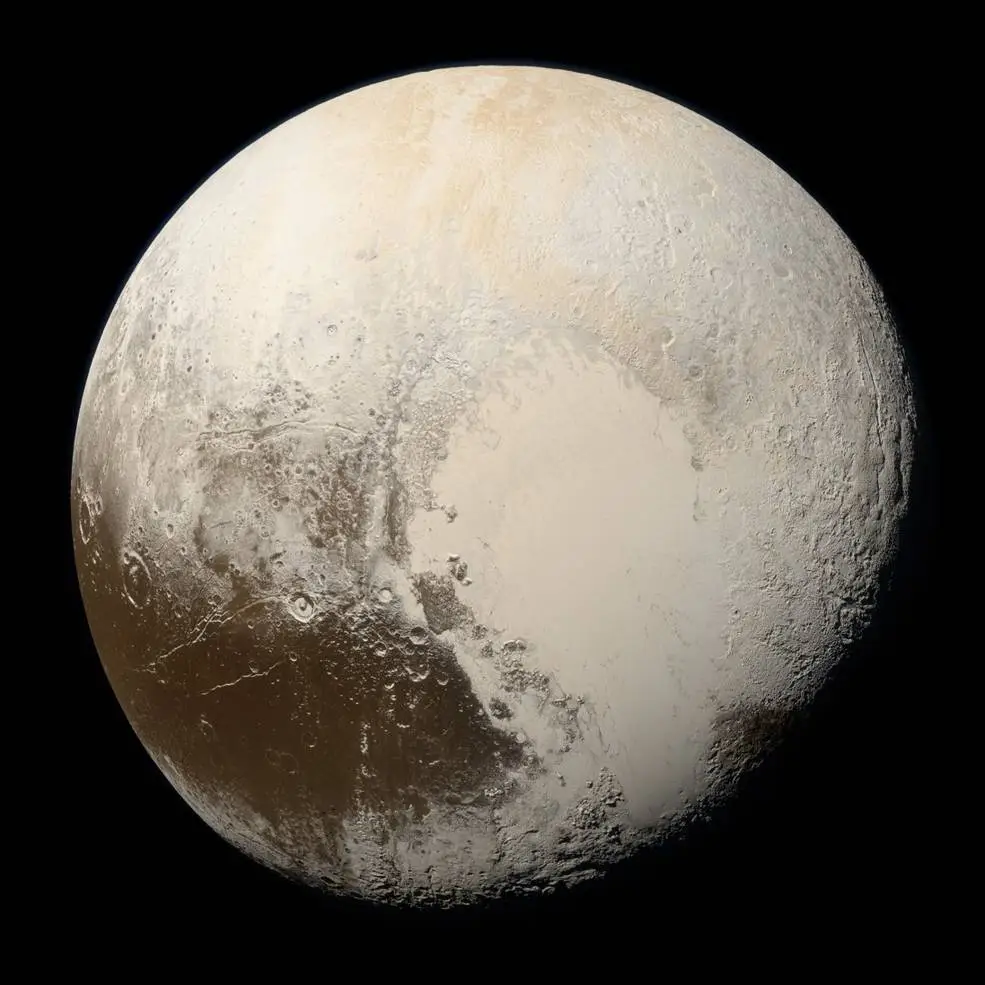 Cool Valentine-shaped feature on Pluto and its largest moon, Icy mountains on Pluto’s surface
Cool Valentine-shaped feature on Pluto and its largest moon, Icy mountains on Pluto’s surface
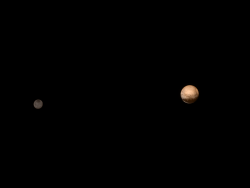 Pluto and its moon Charon, captured in one frame
Pluto and its moon Charon, captured in one frame
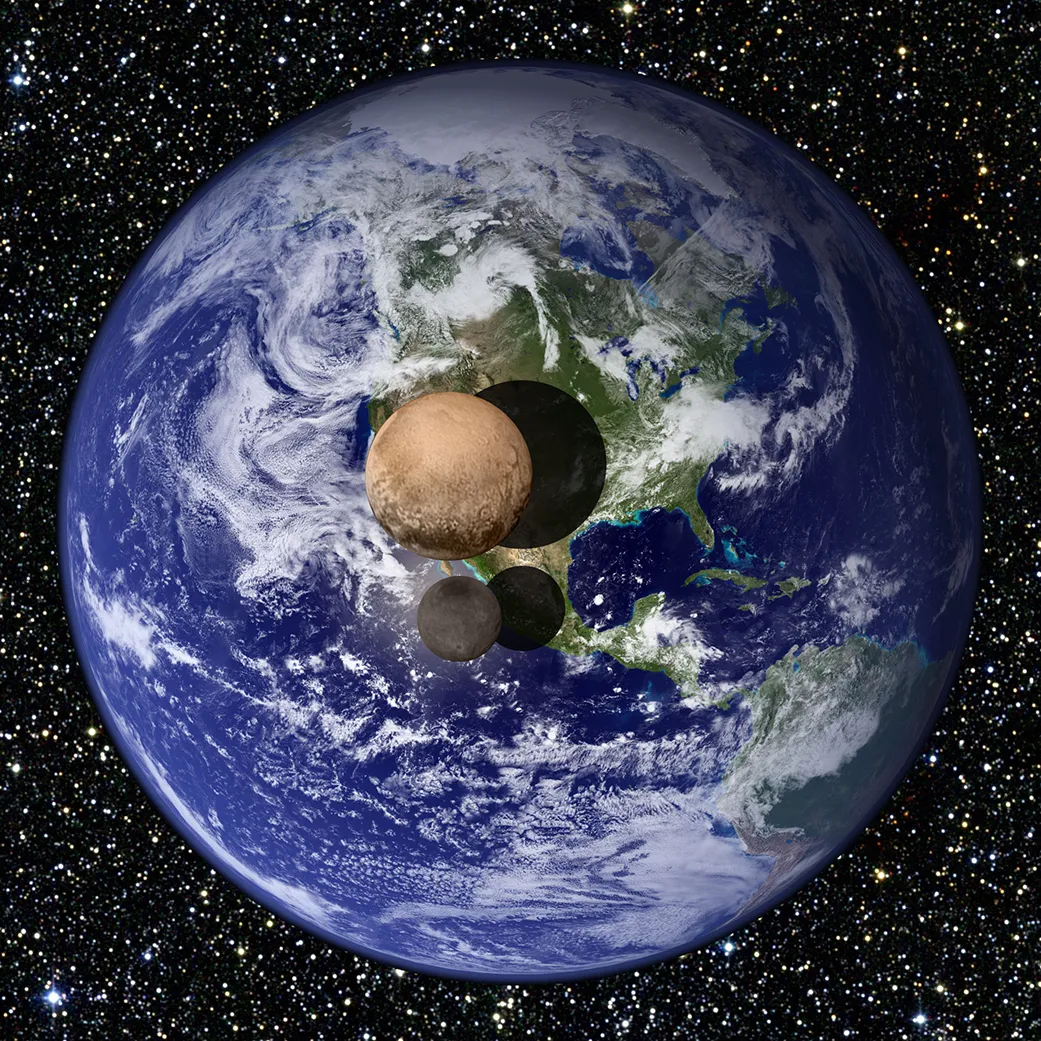 NASA illustration showing the relative sizes of Earth, Pluto, and Charon
NASA illustration showing the relative sizes of Earth, Pluto, and Charon

NASA estimates the icy mountains in this incredible photo of Pluto’s surface, which was taken by the New Horizons spacecraft just 15 minutes after its closest approach, are up to 11,000 feet tall.
Many more amazing images from this mission can be found on this page from NASA’s website:
[Link to NASA’s New Horizons mission images gallery]
________________________________________________________________________________________
 Starling
Starling
Astronomer Michael E. Brown’s Pluto Presentation – 8/17/2015
On August 17, I had the pleasure of hearing Caltech astronomer Michael E. Brown speak at Montgomery Bell Academy in Nashville, Tennessee. Dr. Brown has written several books, including How I Killed Pluto and Why It Had It Coming, which was published in 2010. He often refers to himself as “the man who killed Pluto” because of how his work researching trans-Neptunian objects (TNOs) contributed to the reclassification of Pluto from a major planet to a dwarf planet in 2006.
The “demotion” of Pluto was predicated off of the discovery of similar-sized TNOs in the Kuiper belt. In particular, the discovery of the dwarf planet Eris contributed to Pluto’s reclassification. Eris was originally estimated to be larger than Pluto, although its orbit was farther from the Sun and more elongated than Pluto’s. Below is an image from NASA’s website showing the orbits of the major outer planets in our solar system in comparison with the orbits of Pluto and Eris:

The eight major planets generally orbit in the same plane as the equator of the Sun. In contrast, Pluto’s orbital path is tilted at an angle of 17 degrees above the plane where the major planets orbit, and Eris’s orbit is tilted at an angle of 44 degrees above this plane. Dr. Brown argued that, because Pluto’s and Eris’ sizes and elongated orbits contrast so starkly with those of the eight major planets, Pluto should no longer be classified as a major planet.
The discovery of Eris led many astronomers to question whether other trans-Neptunian dwarf planets should be classified as planets. More Kuiper Belt objects began to be discovered that shared similar characteristics to Pluto. In 2006, the International Astronomical Union (IAU) General Assembly met in Prague and announced an “official” definition of “planet” that required reclassification of Pluto as a dwarf planet. According to the IAU, a planet is now defined as a celestial body that orbits around the sun, has enough mass to assume hydrostatic equilibrium (a nearly round shape), and has “cleared the neighborhood” around its orbit.
Dr. Brown is a very entertaining speaker, and his account of the story behind Pluto’s controversial reclassification was fascinating.
Copyright 2025 StarlingSkyBlog